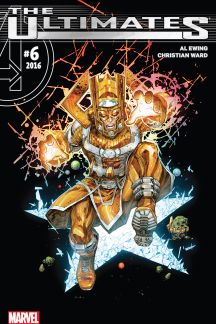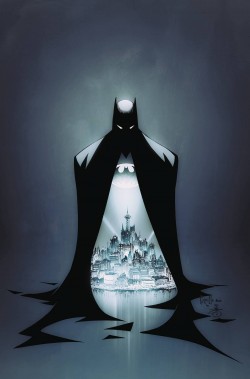Thursday Comics Hangover: Super weird
Superhero comics are supremely weird. What started out as a simple formula — every issue features a fight by page seven, a little bit of soap opera, and the beginning, middle, and end of a battle between good and evil — has now become a weirdly self-reflexive vocabulary that pretty much is only used to describe itself. Even as superhero movies have become the most popular genre at the multiplex, it’s hard to understand modern superhero comics without comparing them against years of knowledge of the genre.

This doesn’t mean they’re necessarily bad. The sixth issue of The Ultimates, written by Al Ewing and illustrated by Christian Ward, is an almost impossibly weird comic book. Unless you’re familiar with fifty years of Marvel superhero history, you’re almost guaranteed to be totally lost. The main character of the story is Galactus, a giant space god who wears a ludicrous helmet and eats planets for a living, as he tries to discover who has chained up the living personification of the universe. Along the way, he hits a giant disembodied space-head right in the face. (“On our level, combat is metaphor,” Galactus explains, “A clash of ideas.” Okay.)
What Ewing is doing with The Ultimates is pushing comic book physics to its limits, examining superhero time travel and its repercussions, and dissecting the impossible sci-fi physics created by Jack Kirby in the 1960s. It’s almost impenetrably postmodern, a wild and weird journey through four-color quantum physics. If you spent years of your youth wondering how the Marvel Universe doesn’t collapse in on itself from all the time-travel and alternate-dimension hopping its heroes do, this is the book for you, a metatextual journey through gaudy superheroic philosophy. If you have no idea what I’m talking about, you should probably give it a miss.
This week also saw the end of writer Scott Snyder and artist Greg Capullo’s run on Batman. Their Batman has been one of the only roundly applauded creative runs of the DC Comics "New 52” reboot initiative, in which their entire line was relaunched in hopes of finding a new audience. (Given that DC is about to reboot their entire line again next month, the New 52 seems to have mostly been a failure.)

Much of Snyder’s reign as writer has, frankly, not appealed to me — his interpretation of the Joker as a psychopathic butcher whose face was removed, dried out, and then worn on top of the exposed muscles of his face as a mask was, uh, a little over-the top. But other parts of Snyder’s run have been incredibly fun, most notably the last stretch, which featured Commissioner Gordon stepping in as Batman in a goofy superhero fantasia.
Thankfully, Batman issue 51 — the final collaboration between Snyder and the highly competent Capullo for the forseeable future — leans more toward the fun superhero side of Batman than the pair of overly grim and gruesome Joker stories Snyder wrote into the run. This is a Batman who has time to joke around with Alfred. He’s confident enough in his masculinity to walk around in Capullo’s smart redesign of the Batman costume, which features splashes of color like yellow and — gasp! — a purple lining to his cape. Sure, the story gets a little hammy, but a Batman comic without operatic symbolism isn’t much of a Batman story, after all.
In the end, Snyder and Capullo are leaving the character in better shape than when they started. Rather than the ridiculously obsessed Batman of the 80s and 90s, their Batman is a little looser, a little more vibrant, and a lot more fun. What’s the point in doing a superhero comic, they seem to be asking, if you’re not going to get a little weird with it?